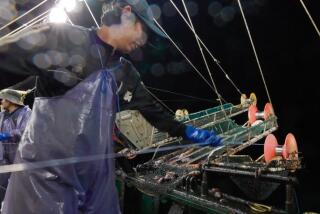Fishy marketing, bad science
Like small boats in an unending squall, U.S. consumers are buffeted from all sides with information about what kind of food to buy and why it’s good -- or bad -- for them. In such a convergence of advertising, news and constant marketing, timely and accurate information is crucial for those who want to make healthy and affordable choices.
That’s why it was so disturbing when a group called the National Healthy Mothers, Healthy Babies Coalition released a report recently encouraging pregnant women to increase their consumption of fish despite the well-known risk of mercury and other contaminants commonly found in certain seafoods.
For years, the Food and Drug Administration and the Environmental Protection Agency have advised women who are pregnant, might become pregnant or are breast-feeding to eat no more than 12 ounces weekly of any type of fish or shellfish that could be high in mercury, a potent neurotoxin. And because of the harm that mercury contained in fish such as shark, swordfish and tuna poses to the developing nervous systems of fetuses and infants, the greater scientific and medical community has been united in echoing this message.
Scientists and doctors feel strongly about underplaying the threat of mercury and other contaminants, such as PCBs, in seafood. In fact, a group of medical and public health professionals last year publicly protested a series of ads in major publications, paid for by the farmed-salmon industry, that touted the health benefits of farmed salmon for pregnant women and their unborn babies. After a Federal Trade Commission investigation of the ad campaign, the industry group instituted stricter advertising review policies.
But it’s hard to stop a powerful, if troubling, marketing strategy once commercial interests take over. The National Fisheries Institute, the main trade association for the fishing industry, paid the travel expenses of the researchers who generated the report for the National Healthy Mothers, Healthy Babies Coalition and gave each of them honorariums of $1,000 to $1,500.
In addition, as reported by National Public Radio, the effort to publicize the report was subsidized by a $60,000 grant from the National Fisheries Institute. Further, Bloomberg News reported that the institute is a client of public relations giant Burson-Marsteller, and one of the firm’s employees serves as vice chairman of the coalition.
Such facts suggest ethical lapses in financing the report; worse, material used in its preparation was flawed. The key study it cited to undermine warnings about mercury-laden fish consumption was an analysis, published this year in the medical journal Lancet, of data gathered in 1992 by the University of Bristol about local children whose mothers ate fish while pregnant. Yet that study’s methodology and conclusions were subsequently challenged in the Lancet by experts with New Jersey’s Department of Environmental Protection and Maine’s Department of Health and Human Services.
And finally, the researchers who developed the report for Healthy Mothers, Healthy Babies didn’t bother to vet its decidedly contentious findings and advice with the coalition’s wider membership before public release. Members such as the March of Dimes and the American College of Obstetricians and Gynecologists subsequently said they stood by the earlier FDA and EPA guidelines, essentially disavowing the report and its recommendations.
The misleading report is a classic example of industry-driven marketing under the cloak of scientific research. Fortunately for consumers, however, the FDA and EPA have just repeated their strong stance on the dangers posed by overconsumption of certain fish, which should help derail the effort to promote sales over children’s health.
Not all fish are equal in nutritional benefits. And the selective repackaging of science, combined with slick marketing to sell more fish to pregnant women and women of childbearing age, show the height of corporate irresponsibility. This is one fishy marketing scheme that consumers should throw back.






